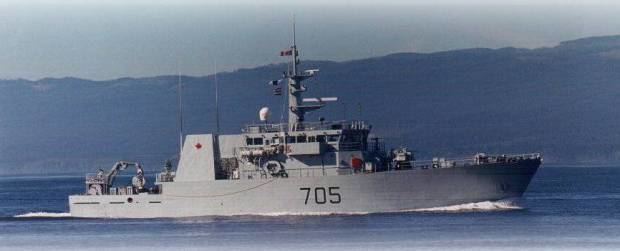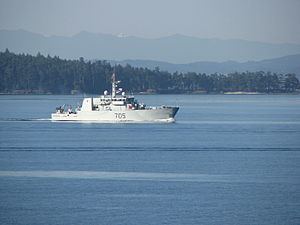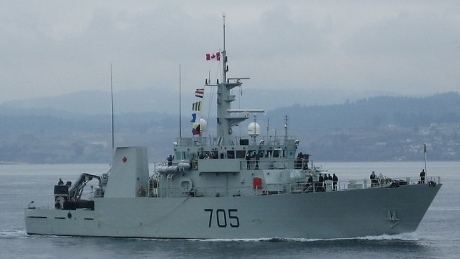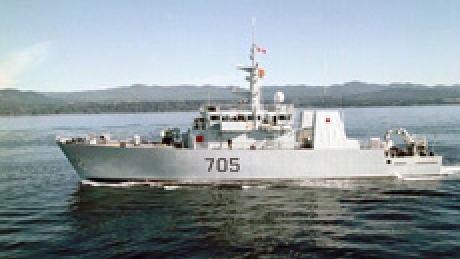Name Whitehorse Laid down 26 July 1996 Construction started 26 July 1996 Length 55 m Builder Halifax Shipyard | Commissioned 17 April 1998 Identification MM 705 Launched 24 February 1997 Draft 3.4 m | |
 | ||
Hmcs whitehorse
HMCS Whitehorse is a Kingston-class coastal defence vessel that has served in the Canadian Forces since 1998. Whitehorse is the sixth ship of her class which is the name for the Maritime Coastal Defence Vessel Project. The first vessel named for the city in the Yukon, the ship is assigned to Maritime Forces Pacific (MARPAC) and is homeported at CFB Esquimalt.
Contents
Hmcs whitehorse in alaska
Design and description

The Kingston class was designed to fill the minesweeper, coastal patrol and reserve training needs of the Canadian Forces, replacing the Bay-class minesweepers, Porte-class gate vessels and Royal Canadian Mounted Police coastal launches in those roles. In order to perform these varied duties the Kingston-class vessels are designed to carry up to three 6.1-metre (20 ft) ISO containers with power hookups on the open deck aft in order to embark mission-specific payloads. The seven module types available for embarkation include four route survey, two mechanical minesweeping and one bottom inspection modules.

The Kingston class displace 970 long tons (990 t) and are 55.3 metres (181 ft 5 in) long overall with a beam 11.3 metres (37 ft 1 in) and a draught of 3.4 metres (11 ft 2 in). The coastal defence vessels are powered by four Jeumont ANR-53-50 alternators coupled to four Wärtsilä UD 23V12 diesel engines creating 7.2 megawatts (9,700 hp). Two LIPS Z-drive azimuth thrusters are driven by two Jeumont CI 560L motors creating 3,000 horsepower (2,200 kW) and the Z drives can be rotated 360°. This gives the ships a maximum speed of 15 knots (28 km/h; 17 mph) and a range of 5,000 nautical miles (9,300 km; 5,800 mi) at 8 knots (15 km/h; 9.2 mph).

The Kingston class is equipped with a Kelvin Hughes navigational radar using the I band and a Kelvin Hughes 6000 surface search radar scanning the E and F bands. The vessels carry an AN/SQS-511 towed side scan sonar for minesweeping and a Remote-control Mine Hunting System (RMHS). The vessels are equipped with one Bofors 40 mm/60 calibre Mk 5C gun and two M2 machine guns. The Kingston-class coastal defence vessels have a complement of 37.
Operational history

Whitehorse was laid down on 26 July 1996 by Halifax Shipyards Ltd. at Halifax, Nova Scotia and was launched on 24 February 1997. The ship underwent sea trials off the Atlantic coast before transferring to the west coast of Canada in August 1997. Whitehorse was commissioned into the Canadian Forces on 17 April 1998 at Esquimalt, British Columbia and carries the hull number MM 705.
As part of Operation Caribbe, Whitehorse deployed to the eastern Pacific Ocean with sister ship, Nanaimo in February 2014. In June 2014, Whitehorse took part in the RIMPAC 2014 naval exercises off southern California. However, she was ordered to return home after allegations of misconduct, including sexual misconduct, occurred while docked in San Diego. Whitehorse is the first Canadian warship to be withdrawn from an exercise due to "reasons of conduct". The incident contributed to the imposition of tighter restrictions on the availability of alcohol on board Royal Canadian Navy warships which were announced in December 2014.
In February 2015, Whitehorse was deployed as part of Operation Caribbe. In early March 2015, Whitehorse, in conjunction with the United States Navy frigate USS Gary and the United States Coast Guard cutter USCGC Boutwell, intercepted a freighter in international waters in the eastern Pacific Ocean that led to the seizure of 5,200 kilograms (11,500 lb) of cocaine. In late March, Whitehorse assisted the US Coast Guard in a second drug bust, this time in international waters off El Salvador. Over 600 kilograms (1,300 lb) of cocaine was seized in the operation. The coastal defence ship returned to Canada on 15 April 2015. On 10 June 2015, Whitehorse aided the stricken pleasure craft Amora Mai whose engine had caught fire 6 nautical miles (11 km; 6.9 mi) east of Robson Point, British Columbia. Whitehorse towed the damaged vessel to Port McNeill.
In October 2015, Whitehorse deployed with Brandon off the Pacific coast of North America as part of Operation Caribbe. During their deployment, Whitehorse performed one seizure of a smuggling vessel. In total, seven seizures were performed interdicting a total of nearly 9,800 kilograms (21,600 lb) of cocaine. The two ships returned to Canada in December.
